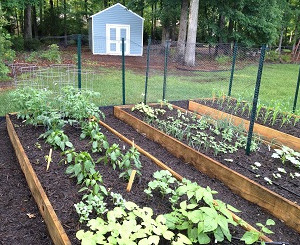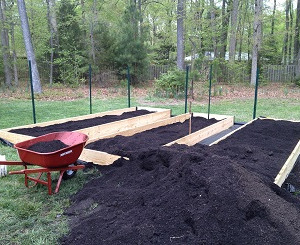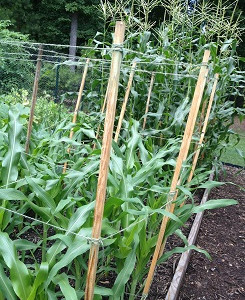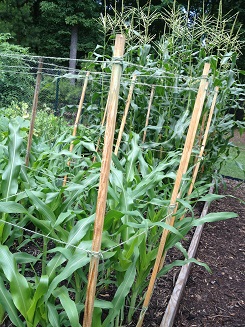A Shared Raised Bed Garden
Durhamites Valerie K. and her family, plus their neighbor, Jeni H., decided to take on a DIY gardening project to ensure that their family would eat more local, organic fruits and vegetables. They installed three raised garden beds, each 4 ft. x 16 ft. x 1 ft. (tall) that will provide them with plenty of delicious, fresh food all season long. In North Carolina that can last all the way from April through October! Gotta love North Carolina, even the heat. Here is her story and a list of building materials and instructions if you would like to tackle this project yourself one day.
Question: What made you decide to install raised beds?
Valerie: For many years we have had several large pots of tomatoes, peppers, herbs, etc. on our back deck. Our neighbor Jeni had her own deck garden as well, with cucumbers and lettuce, etc. We both wanted to expand our options and try for more variety so we hatched a plan. The only suitably sunny location for our shared garden was between our two homes so the garden ended up half on our property, half on Jeni’s.
Question: Tell me the specifics of how you went about this, how many beds did you build? What raw materials did you have to purchase?
Valerie: We have three raised beds, each is 4 ft. x 16 ft. x 1 ft. (tall), with about a 2-foot aisle between and around the perimeter. Materials purchased include:
-Six 16-foot untreated boards and two 12-foot boards, which the local improvement store cut into six 4-foot sections. We chose untreated to keep chemicals from leaching into the soil and into our food.
-12 heavy-duty metal corner pieces from an online gardening center to assemble the beds (these corners make it so much easier to put together your lumber, rather than try to nail/screw the heavy, long, awkward wooden boards together. Also, we feel like we can easily replace the lumber, which is why we were able to go with untreated lumber.)
-Roll of weed barrier from a local home improvement center.
-Newspaper – use some that needs to be recycled!
-7 cubic yards of high quality compost (mixture of topsoil and compost) from local garden shop.
-4 cubic yards of mulch from local garden shop.
-Fence: Thirteen 7-foot posts, 84-in. x 100-ft. black plastic/polyresin deer fencing, and zip ties purchased from local home improvement center.The fence is necessary to protect food from wildlife (rabbits, deer, possum, etc).
Instructions:
-Level the ground where the beds will be. Put together the beds using four pieces of lumber per bed. We used two 4-foot pieces for the ends, and two 16-foot pieces for the sides, plus the four corner pieces.
-Weed barrier was laid down in the walkways. We tucked the material under the garden boards to keep the material in place, and then tucked the fence under the weed barrier material on the outside to help keep critters out. Line the bottom of the beds with newspaper. -Fill the beds with compost mixture. Use the mulch for walkways around the beds, and eventually over the plants for weed control.
-Fence: Bury 2 feet of the posts underground, leaving the posts 5 feet tall. There is a post at each corner of the garden, and two on each side spaced evenly about every 7 feet. On the side with the opening we placed one more post to make the gate area smaller. Attach fencing to the posts with zip ties. Overall the fenced in area is about 21 x 21 feet.
Additional materials/instructions:
-Drip irrigation system – we chose one that uses adjustable emitters on half-inch tubing and installed a coupler to connect to a garden hose. This technical set up for watering isn’t necessary, but makes it so much easier for two working families to take care of the garden’s watering needs.
-We installed a plastic border material called “edging” around the perimeter to contain the mulch, also as another line of defense against critters trying to get under the fence. The edging is about 8-inches high with 2-4 inches placed underground. Each piece is about 10-inches wide and they slide together to make the border whatever size you want.
-9 feet of chicken wire (double height) was installed between two additional fence posts in the middle of the garden for climbing plants, like peas and beans.
-Cages for the tomatoes. These are not necessary, but look really cool, and support taller plants.
Question: How did you budget for this project?
Valerie: We took a long-term approach to this project, and we are sharing the expense between our households as well. So, we made a large investment at first but we hope that there will be minimal investment in the years to come. We may have splurged a bit on corner pieces or drip irrigation. However, we are all busy professionals so we look at these as time savers – the drip irrigation may be a potential garden saver in the heat of a North Carolina summer!
Question: What plants or seeds have you planted?
Valerie: We dedicated one entire bed to corn – half the bed is planted now, and the plants are about a foot tall already. We will stagger plant the other half in a few weeks, so that not all our corn matures at once . . . or at least we hope to have that problem.
We have planted all kinds of wonderful treats:
-peas (traditional and sugar snap) beans (golden wax, pole, stringless bush)
-onions (red, white, yellow, sweet) carrots (regular and a small variety)
-beets
-cucumbers
-lettuce (‘Black Seeded Simpson,’ ‘Salad Bowl,’ and ‘Super Fresh’)
-summer squash and zucchini
-We started from plants for tomatoes (traditional red varieties: ‘Park’s Whopper,’ Roma, Patio; heirloom varieties: ‘Cherokee Purple,’ ‘Mr. Stripey’)
-Peppers (red, orange, yellow, green bells, hot banana, and serrano chili)
Question: If you can, estimate your time spent building these beds.
Answer: We spent two full weekends to complete the majority of the work. We had some expert assistance from Jeni’s parents one weekend. The first weekend was spent on garden placement, planning layout, bed construction, and putting in the majority of the fence posts. The night that the compost and mulch were delivered was two full evenings of work with the pitchfork and wheelbarrow. The second weekend we installed the drip irrigation and completed the fence so that we could finally plant something!
Question: What do you personally do to stay healthy?
Valerie: We have been committed to eating what is fresh and local for some time now. We are members of a great CSA and have made a few trips to farmer’s markets along the way. With so much fresh stuff to choose from, there is little need for processed, packaged food when steaming some veggies is so easy!
A version of this story was originally published by Amanda Baley on Foodie Mama Talks.






